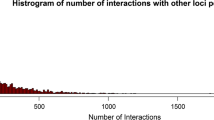Abstract
The application of the selection index in the case of an additive two-trait model in which the genetic effect on each trait is determined by a finite number of loci is examined. Simulation results indicate that the direction of change in the frequency of favourable alleles is not necessarily in the positive direction at all loci when index selection is used as the basis for truncation selection. When the genetic correlation was positive (or favourable with respect to the economic weights), there was little difference (<5%) in genetic gain over 20 generations and no difference in the direction of change in allele frequencies or genetic correlation whether or not updated values for the genetic (co)variances were used in constructing the selection index. However, when the genetic correlation was negative or unfavourable, the effect of using genetic parameters which were not updated had unexpected effects on the allele frequencies and genetic correlation and reduced the genetic gain by a greater amount (< 12%).
Similar content being viewed by others
References
Bohren BB, Hill WG, Robertson A (1966) Some observations on asymmetrical correlated responses. Genet Res 7:44–57
Bulmer MG (1985) The mathematical theory of quantitative genetics. Oxforrd University Press, Oxford
Crow JF, Kimura M (1970) An introduction to population genetics theory. Harper and Row, New York
de Konig, GK, Weller JI (1994) Efficiency of direct selection on quantitative trait loci for a two-trait breeding objective. Theor Appl Genet 88:669–677
Harris DL (1964) Expected and predicted progress from index selection involving estimates of population parameters. Biometrics 20:46–72
Hayes JF, Hill WG (1980) A reparametrization of a genetic selection index to locate its sampling properties. Biometrics 36:237–248
Kennedy BW, Sorensen DA (1988) Properties of mixed model methods for prediction of genetic merit. In:Weir GS, Eisen EJ, Goodman MM, Namkoong G (ed) Proc 2nd Int Conf Quant Genet. Sinaur, Sunderland, Mass., p 91
Koots KR, Gibson JP (1994) How precise are genetic correlation estimates? In: Smith C, Gavora JS, Benkel B, Chesnais J, Fairfull W, Gibson JP, Kennedy BW, Burnside EB (eds) University of Guelph, Guelph Ont. Proc 5th World Congr Genet Appl Livest Prod, Vol 18, pp 353–356
Lander EL, Botstein D (1989) Mapping Mendelian factors underlying quantitative traits using RFLP linkage maps. Genetics 121:185–199
McMillan I, Robertson A (1974) The power of methods for the detection of major genes affecting quantitative characters. Heredity 32.3:349–356
McMillan I, Friars GW, Quinton VM (1973) The effect of simultaneous selection on the genetic correlation. In: Proc 13th, Congr Genet. S169 (abstr)
McMillan, I, Fairfull RW, Friars GW, Quinton VM (1995) The effect of simultaneous selection on the genetic correlation. Theor Appl Genet 91:776–779
Quinton M, Smith C (1995) Comparison of evaluation-selection systems for maximising genetic response at the same level of inbreeding. J Anim Sci 73:2208–2212
Quinton M, Smith C, Goddard ME (1992) Comparison of selection methods at the same level of inbreeding. J Anim Sci 70:1060–1067
Smith C (1983) Effects of changes in economic weights on the efficiency of index selection. J Anim Sci 56:1057–1064
van Arendonk JAM, Bovenhuis H, van der Beek S, Groen AF (1994) Detection and exploitation of markers linked to quantitative traits in farm animals. In: Smith C, Gavora JS, Benkel B, Chesnais J, Fairfull W, Gibson JP, Kennedy BW, Burnside EB (eds) University of Guelph, Guelph Ont. Proc 5th World Congr Genet Appl Livest Prod, Vol 18, pp 193–200
Young SSY (1961) A further examination of the relative efficiency of three methods of selection for gains under less-restricted conditions. Genet Res 2:106–121
Villanueva B, Kennedy BW (1990) Efficiency of indirect selection with a finite number of loci. In: Hill WG, Thompson R, Woolliams JA (eds) Edinburgh, Scotland. Proc 4th World Congr Genet Appl Livest Prod, Vol 12, pp 265–268
Author information
Authors and Affiliations
Additional information
Communicated by E. J. Eisen
Rights and permissions
About this article
Cite this article
Quinten, M., McMillan, I. The effect of index selection on allele frequencies and future genetic gains when traits are correlated. Theoret. Appl. Genetics 93, 1335–1342 (1996). https://doi.org/10.1007/BF00223467
Received:
Accepted:
Issue Date:
DOI: https://doi.org/10.1007/BF00223467



